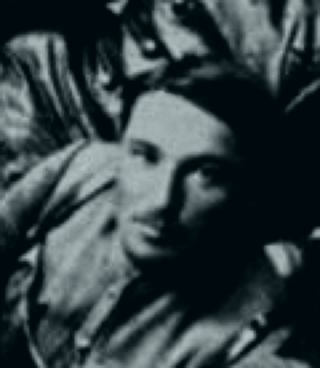The Battle of Peregonovka was a September 1919 military conflict in which the Revolutionary Insurgent Army of Ukraine defeated the Volunteer Army. After retreating west across Ukraine for four months and 600 kilometers, the Insurgent Army turned east and surprised the Volunteer Army. The Insurgent Army reclaimed its capital of Huliaipole within ten days.
Mark Mratchny was a Belarusian Jewish writer, anarcho-syndicalist and a member of the Makhnovist movement.

Panteleimon "Panteley" Fyodorovich Belochub, , was a Ukrainian soldier best known as one of the commanders of the Revolutionary Insurgent Army of Ukraine, a major belligerent force during the Russian Civil Wars of 1917 – 1921.

The 1st Donetsk Corps was a military formation of the Revolutionary Insurgent Army of Ukraine, it was created on 1 September 1919 and existed until 1920.
The 2nd Azov Corps was a military formation of the Revolutionary Insurgent Army of Ukraine, one of the 4 corps that was created on 1 September 1919, and existed until 1920.

The Air Fleet of the Revolutionary Insurgent Army of Ukraine was one of the branches of the Revolutionary Insurgent Armed Forces.
Vladimir Feofanovich Takhtamyshev (1890s–1935) was a Ukrainian Greek participant in the Russian Civil War, as part of the Makhnovist movement.
Tymofiy Lashkevych was a Ukrainian anarcho-communist that fought with the Makhnovists during the Ukrainian War of Independence as commander of the 1st Donetsk Corps.
Oleksandr Kalashnykov was a Ukrainian anarchist and a commander of the 1st Donetsk Corps of the Revolutionary Insurgent Army of Ukraine.
Mikhail Uralov was a Russian anarchist, the head of the "Black Guard" combat units of the Moscow Federation of Anarchists and a commander of the Revolutionary Insurgent Army of Ukraine.
The Azov-Black Sea Flotilla was a formation of the Makhnovist fleet, the main area of which was the Sea of Azov.
The Memory of Hryhorii Makhno was an armored train of the Revolutionary Insurgent Army of Ukraine, which consisted of two cars with 10 machine guns and two cannons.
Hryhorii Ivanovych Makhno was a Ukrainian rebel commander and brother of Nestor Makhno.
Grigory Savelievich Maslakov, "Maslak" (1877-1921) was a Russian military leader during the Russian Civil War.
Oleksiy Vasylovych Chubenko was a diplomat for the Revolutionary Insurgent Army of Ukraine.
Ivan Chuchko (1889–1919) was a military commander in the Revolutionary Insurgent Army of Ukraine.
Savelii Ivanovych Makhno was a Ukrainian anarcho-communist, member of the Makhnovist movement, and brother of Nestor Makhno.
The Battle of Mariupol was fought between the 1st Zadneprovsk Ukrainian Soviet Division and the Volunteer Army, during March 1919.
Vasyl Mikhailovych Sharovsky was a member of the Central Council of Ukraine, an anarcho-communist and an artillery commander of the Revolutionary Insurgent Army of Ukraine.
Ivan Sebastianovich Chernoknizhny was a left socialist-revolutionary and a leading member of the Makhnovist movement.


